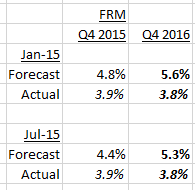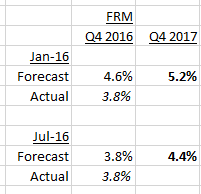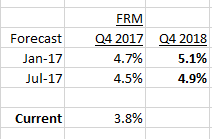Are mortgage rates going to 5%?
I read this comment recently: “Freddie Mac’s Primary Mortgage Market Survey shows that interest rates for a 30-year mortgage have hovered around 4%. Most experts predict that rates will rise over the next 12 months. The Mortgage Bankers Association, Fannie Mae, Freddie Mac and the National Association of Realtors are in unison, projecting that rates will increase by this time next year.”
The Mortgage Bankers Association (MBA) is the United States national association representing some 2,200 companies involved in mortgage finance. MBA produces monthly forecasts of, among other things, the 30 year Fixed Rate Mortgage (FRM) rate. With their knowledge base, it might be reasonable to expect their forecasts to be quite accurate, so let’s look at their forecasts in recent years. In particular, I want to look at their forecasts for the year after the one in which the forecast was made.
2014
Throughout 2014 MBA expected the 2015 FRM to be over 5%. It was 4.0%.
2015
Throughout 2015 the MBA expected the 2016 FRM to be well over 5% (are you seeing a pattern here?) It was 3.8%.
2016
At the start of 2016 the MBA expected the 2017 FRM to be over 5%, but by July had lowered the forecast to 4.4%.
2017
At the start of 2017 the MBA forecast the 2018 FRM to be – yes, over 5%. By July the forecast had dropped to 4.9%, a level maintained in its September forecast just published.
How were the current year forecasts?
As I have pointed out many times in my articles on mortgage rate, forecasting the future is….. complicated. And like hurricane forecasts, the further out the prediction, the greater is the likely margin of error. But MBA has not done much better with its current year forecasts, as can be seen in the tables. Its over-estimate at the beginning of the year was 1.1% in 2014, 0.9% in 2015 and 0.8% in 2016. And rates will have to jump before the end of the year if 2017 is to be any better, as the current rate is 0.9% below the MBA forecast in January.
Why has MBA been so wrong?
The FRM rate is based upon a margin over the yield on the US Treasury 10 year note (10T). In recent years that margin has averaged 1.7%. In general, the yield on 10T reflects economic performance and expectation. And many economists, not just MBA’s, have been forecasting that, with all the financial stimulus injected in recent years, inflation would pick up as the economic expansion created more demand for goods and workers. And higher inflation would lead to higher interest rates being demanded by buyers of fixed income securities such as 10T.
I have written many articles since the Federal Reserve started increasing short-term interest rates in December 2015 pointing out that the Fed Funds rate influences things like auto loans, credit card rates and adjustable rate mortgages, but that the FRM follows 10T.
What will happen to mortgage rates in 2018?
The point of this post is not to point fun at MBA’s economists and neither is it to make a forecast for 2018. It is to point out, once again,that home buyers should be focused on finding the right house – a difficult enough task with today’s lack of inventory- rather than mortgage rates. And as a mortgage broker friend pointed out to me, anybody who could refinance in recent years has already done so to lock in recent low rates.
The key to knowing what will happen to the FRM is to follow one number – the yield on 10T.
Are you thinking about selling? Read Which broker should I choose to sell my house?
Please contact me on 617.834.8205 or Andrew.Oliver@SothebysRealty.com for a free market analysis and explanation of the outstanding marketing program I offer
If you are looking to buy, I will contact you immediately when a house that meets your needs is available. In this market you need to have somebody looking after your interests.
Andrew Oliver is a Realtor with Harborside Sotheby’s International Realty. Each Office Is Independently Owned and Operated
@OliverReports




